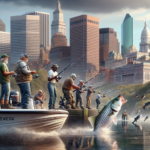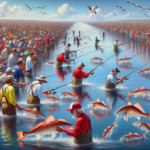Striped Bass Fishing Tournament in Massachusetts

Introduction
Did you know that the striped bass, also known as the “striper,” is one of the most sought-after game fish in Massachusetts? Every year, anglers from all over the country flock to the Bay State to participate in striped bass fishing tournaments, hoping to land the big one and claim bragging rights. This article will delve into the exciting world of striped bass fishing tournaments in Massachusetts, covering everything from the best fishing techniques and gear to the top fishing spots and seasonal considerations.
Whether you’re a seasoned angler looking to hone your skills or a novice eager to learn the ropes, understanding the intricacies of striped bass fishing in Massachusetts can significantly enhance your experience. This guide will provide you with all the information you need to prepare for a successful fishing trip or tournament, ensuring you make the most of your time on the water.
Background/Context
Historical or Cultural Significance
Striped bass fishing has a rich history in Massachusetts, dating back to the early colonial period. The fish was a staple for Native American tribes and early settlers, providing a reliable source of food. Over the centuries, striped bass has become a symbol of the region’s fishing culture, celebrated in local festivals and tournaments.
Geographical Overview
Massachusetts boasts a diverse range of fishing environments, from the rocky shores of Cape Ann to the sandy beaches of Cape Cod. The state’s coastal waters are teeming with striped bass, thanks to the nutrient-rich currents of the Atlantic Ocean. The local ecosystem, characterized by estuaries, bays, and tidal rivers, provides an ideal habitat for this prized species.
Key Points/Details
Fishing Techniques
Technique Overview
Several techniques are effective for catching striped bass, including surfcasting, trolling, and fly fishing. Surfcasting involves casting bait or lures from the shore, while trolling uses a moving boat to drag lures through the water. Fly fishing, though less common, can be highly effective in shallow waters and estuaries.
When and Where to Use
Surfcasting is best suited for beaches and rocky shores, particularly during the early morning or late evening when striped bass are most active. Trolling is ideal for deeper waters and can be done throughout the day. Fly fishing is most effective in estuaries and tidal rivers, especially during the spring and fall migrations.
Recommended Gear
- Rods: Medium to heavy-action rods for surfcasting and trolling; lightweight rods for fly fishing.
- Reels: Spinning reels for surfcasting; conventional reels for trolling; fly reels for fly fishing.
- Lines: Braided lines for surfcasting and trolling; floating lines for fly fishing.
- Bait/Lures: Live bait (e.g., eels, bunker), soft plastics, topwater plugs, and flies.
Species Information
Species Overview
Striped bass are known for their distinctive dark stripes running along their silvery bodies. They are migratory fish, spending their summers in the cooler waters of the North Atlantic and migrating south during the winter. Striped bass prefer coastal waters, estuaries, and tidal rivers, where they feed on smaller fish and crustaceans.
Best Practices
To successfully catch striped bass, it’s essential to understand their feeding habits and preferred habitats. Using live bait or lures that mimic their natural prey can increase your chances of success. Additionally, fishing during the early morning or late evening, when striped bass are most active, can yield better results.
Location Information
Top Fishing Spots
- Cape Cod Canal: Known for its strong currents and abundant striped bass population, the canal is a favorite among anglers.
- Martha’s Vineyard: This island offers excellent surfcasting opportunities, particularly along its southern shores.
- Boston Harbor: The harbor’s estuaries and tidal rivers provide ideal conditions for striped bass fishing.
- Plum Island: Located near Newburyport, this spot is famous for its productive surfcasting beaches.
Regulations and Licenses
Massachusetts requires all anglers to have a valid saltwater fishing license. Additionally, there are specific regulations regarding catch limits and size restrictions for striped bass. As of 2023, the minimum size limit is 28 inches, and the daily bag limit is one fish per angler. It’s crucial to stay updated on local regulations to ensure compliance and support conservation efforts.
Seasonal Considerations
Seasonal Variations
Striped bass fishing in Massachusetts varies throughout the year. The spring and fall migrations are peak times, with large numbers of fish moving along the coast. Summer offers consistent fishing opportunities, particularly in deeper waters, while winter sees a decline in activity as striped bass migrate south.
Best Times to Fish
The best times to fish for striped bass are during the spring (April to June) and fall (September to November) migrations. Early morning and late evening are the most productive times of day, as striped bass are more active during low light conditions.
Events and Tournaments
Event Overview
Massachusetts hosts several striped bass fishing tournaments throughout the year, attracting anglers of all skill levels. Notable events include the Martha’s Vineyard Striped Bass and Bluefish Derby, the Cape Cod Canal Striper Classic, and the Boston Harbor Striper Shootout. These tournaments offer cash prizes, trophies, and the chance to compete against some of the best anglers in the region.
Preparation Tips
- Gear: Ensure your gear is in top condition, with fresh lines, sharp hooks, and well-maintained reels.
- Practice: Spend time practicing your casting and retrieval techniques to improve accuracy and efficiency.
- Strategy: Research the tournament location and develop a strategy based on local conditions and fish behavior.
Tips and Best Practices
General Tips
- Always check the weather forecast before heading out to ensure safe and comfortable fishing conditions.
- Use a fish finder to locate schools of striped bass and increase your chances of success.
- Keep a fishing log to track your catches, noting the time, location, and conditions for future reference.
Avoid Common Mistakes
- Avoid using overly heavy tackle, as it can reduce sensitivity and make it harder to detect bites.
- Don’t ignore local regulations and size limits, as violations can result in fines and harm fish populations.
- Refrain from overfishing a single spot; move around to find active fish and reduce pressure on specific areas.
Advanced Techniques
- Master the art of “reading the water” to identify potential fish-holding structures and currents.
- Experiment with different retrieval speeds and patterns to trigger strikes from hesitant fish.
- Learn to tie advanced knots, such as the FG knot, for stronger and more reliable connections.
Gear and Equipment Recommendations
Essential Gear
- Medium to heavy-action rod and spinning reel for surfcasting.
- Conventional rod and reel for trolling.
- Lightweight fly rod and reel for fly fishing.
- Braided fishing line for strength and sensitivity.
- Assorted lures, including topwater plugs, soft plastics, and jigs.
- Live bait, such as eels and bunker.
Optional Gear/Upgrades
- Fish finder for locating schools of striped bass.
- Waders for surfcasting in deeper waters.
- Polarized sunglasses to reduce glare and improve visibility.
- Tackle box with organized compartments for easy access to gear.
Where to Buy or Rent
Local bait and tackle shops, such as Red Top Sporting Goods in Buzzards Bay and Goose Hummock Shop in Orleans, offer a wide range of gear and equipment. Online retailers like Bass Pro Shops and Cabela’s also provide extensive selections and convenient shipping options.
Safety and Conservation
Safety Tips
- Always wear a life jacket when fishing from a boat or in deep waters.
- Be aware of weather conditions and avoid fishing during storms or rough seas.
- Stay hydrated and protect yourself from the sun with sunscreen and appropriate clothing.
Conservation Practices
- Practice catch and release to help maintain healthy fish populations.
- Respect local wildlife and avoid disturbing nesting areas or habitats.
- Follow all fishing regulations and size limits to support sustainable fishing practices.
Planning Your Trip
Accommodations
Massachusetts offers a variety of accommodations near popular fishing spots, ranging from budget-friendly motels to luxurious resorts. Notable options include the Harbor View Hotel on Martha’s Vineyard, the Sea Crest Beach Hotel in Falmouth, and the Beauport Hotel in Gloucester.
Travel Tips
- Plan your route in advance and consider traffic conditions, especially during peak tourist seasons.
- Check ferry schedules if traveling to islands like Martha’s Vineyard or Nantucket.
- Consider renting a car for easy access to multiple fishing spots and flexibility in your itinerary.
Additional Activities
Massachusetts offers a wealth of activities for non-fishing time, including hiking, whale watching, and exploring historic sites. Visit the Cape Cod National Seashore, take a whale-watching tour from Provincetown, or explore the historic streets of Boston for a well-rounded trip.
Frequently Asked Questions (FAQs)
Do I need a license to fish for striped bass in Massachusetts?
Yes, a valid saltwater fishing license is required for all anglers in Massachusetts. Licenses can be purchased online or at local bait and tackle shops.
What is the best time of year to fish for striped bass in Massachusetts?
The best times to fish for striped bass are during the spring (April to June) and fall (September to November) migrations.
What gear do I need for striped bass fishing?
Essential gear includes a medium to heavy-action rod, spinning or conventional reel, braided fishing line, and a variety of lures or live bait. Optional gear includes a fish finder, waders, and polarized sunglasses.
Are there any size or catch limits for striped bass in Massachusetts?
Yes, as of 2023, the minimum size limit for striped bass is 28 inches, and the daily bag limit is one fish per angler. Always check current regulations before fishing.
Conclusion
Striped bass fishing in Massachusetts offers an exciting and rewarding experience for anglers of all skill levels. By understanding the best techniques, gear, and locations, you can increase your chances of success and enjoy a memorable fishing trip. Whether you’re participating in a tournament or simply enjoying a day on the water, the tips and information provided in this guide will help you make the most of your striped bass fishing adventure in Massachusetts.
So grab your gear, head to the Bay State, and get ready to reel in some impressive striped bass. Happy fishing!


